
Ah, duckweed. The bane of every pond owner's existence. This tiny, free-floating plant might look harmless at first, but give it an inch and it'll take a mile. Before you know it, your once crystal-clear pond is a sea of green, choking out sunlight and making life difficult for your fish and other aquatic life. But fear not, dear reader, for we have the ultimate solution to banish this pesky pond plant once and for all. So, grab your gardening gloves and let's get to work!
Understanding the Enemy: What is Duckweed?
Before we dive into the nitty-gritty of duckweed removal, let's take a moment to understand our enemy. Duckweed, also known as Lemna minor, is a small, free-floating aquatic plant. It's one of the smallest flowering plants in the world, with each plant measuring just 1-3mm in diameter. It's a fast grower, capable of doubling its population in just 48 hours under the right conditions.
While it might look pretty floating on the surface of your pond, duckweed is a real troublemaker. It blocks sunlight from reaching the water's surface, which can harm aquatic plants and disrupt the ecosystem. It also depletes the oxygen levels in the water, which can be harmful to fish and other aquatic life.
The Battle Plan: How to Get Rid of Duckweed
Now that we know what we're dealing with, let's get down to business. Here's a step-by-step guide on how to get rid of duckweed from your pond.
Step 1: Manual Removal
The first step in your duckweed removal journey is manual removal. This involves physically removing the duckweed from the surface of your pond. You can use a net, a rake, or even your hands (if you're feeling brave) to scoop out the duckweed. This can be a tedious process, especially if your pond is large or heavily infested, but it's a necessary first step.
Remember, duckweed is a fast grower, so you'll need to be diligent about manual removal. It's a good idea to check your pond for duckweed every few days and remove any new growth as soon as you spot it.
Step 2: Biological Control
Once you've removed as much duckweed as you can manually, it's time to bring in the big guns: biological control. This involves introducing natural predators of duckweed into your pond to help control the population.
There are several creatures that eat duckweed, including ducks (hence the name), fish like grass carp and koi, and even some species of turtles. Introducing these creatures into your pond can help keep the duckweed population in check.
Step 3: Chemical Control
If manual removal and biological control aren't enough to banish the duckweed from your pond, you might need to resort to chemical control. This involves using a herbicide specifically designed to kill duckweed.
It's important to use these chemicals carefully, as they can harm other plants and animals in your pond if used incorrectly. Always follow the manufacturer's instructions and use the minimum amount necessary to get the job done.
Prevention is Better than Cure: How to Prevent Duckweed
Now that you've gotten rid of the duckweed, let's talk about how to keep it from coming back. After all, prevention is better than cure, right?
Proper Pond Maintenance
The key to preventing duckweed is proper pond maintenance. This includes regularly checking your pond for signs of duckweed, keeping your pond clean, and maintaining a healthy ecosystem.
Regularly removing fallen leaves and other debris from your pond can help prevent duckweed, as these materials can provide the nutrients that duckweed needs to grow. It's also a good idea to have a good mix of aquatic plants in your pond to compete with the duckweed for resources.
Control Nutrient Levels
Duckweed thrives in nutrient-rich water, so controlling the nutrient levels in your pond can help prevent a duckweed infestation. This can involve using a pond filter to remove excess nutrients, regularly changing the water in your pond, and avoiding overfeeding your fish.
FAQs
Is duckweed harmful to fish?
While duckweed itself is not harmful to fish, it can deplete the oxygen levels in the water, which can be harmful to fish and other aquatic life.
Can I use duckweed as fish food?
Yes, some fish like koi and grass carp will eat duckweed. However, it's not a good idea to rely on duckweed as the sole source of food for your fish, as it doesn't provide all the nutrients they need.
Can duckweed kill other plants?
Duckweed can block sunlight from reaching the water's surface, which can harm other aquatic plants. So, while it doesn't directly kill other plants, it can make it difficult for them to survive.
So there you have it, the ultimate solution to banish the pesky pond plant known as duckweed. With a bit of hard work and persistence, you can reclaim your pond and enjoy a duckweed-free existence. Now, isn't that a quacking good idea?















